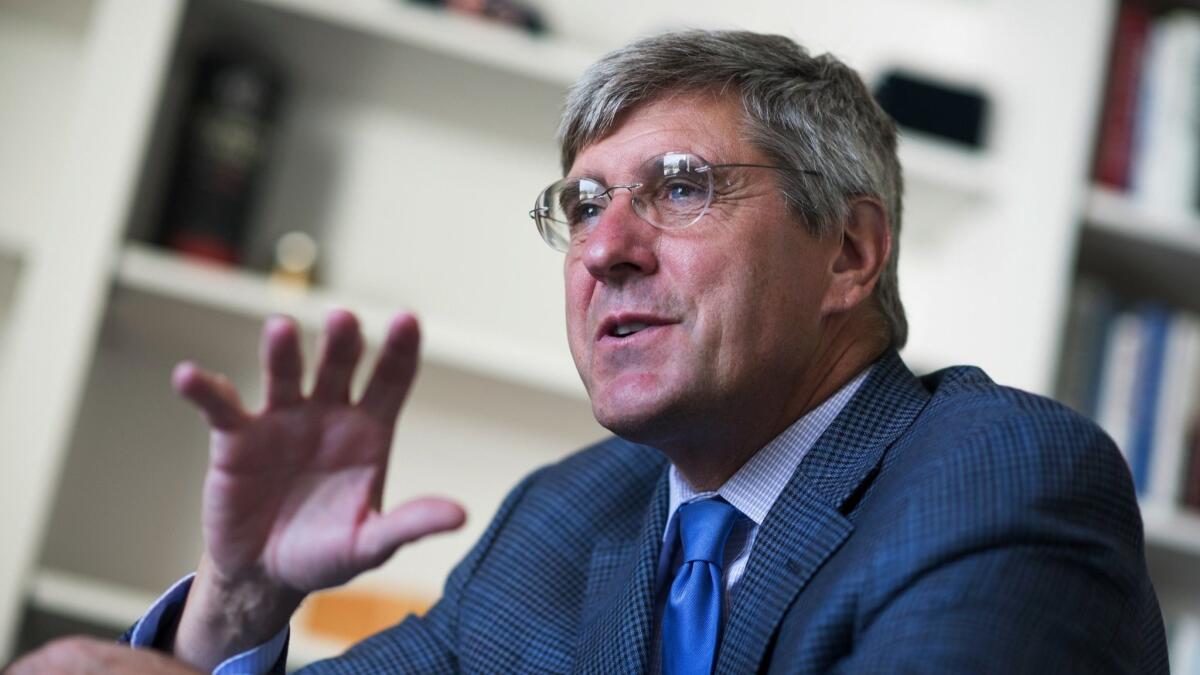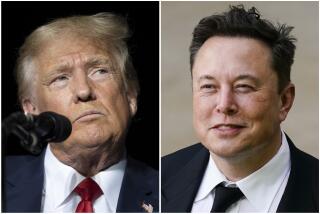Column: Stephen Moore, Trump’s pick for the Fed, just got a key immigration program dead wrong

- Share via
President Trump’s planned nomination of fiscal commentator Stephen Moore for a seat on the Federal Reserve Board has been taking on water since it was announced last month.
Critics have pointed to Moore’s lack of economic credentials, his advocacy of disastrously misguided fiscal policies, his factual inaccuracies and questionable personal finances. Even conservative economists such as N. Gregory Mankiw think the Moore nomination is ridiculous. Trump hasn’t backed off the planned nomination, but new questions about Moore’s qualifications keep getting raised.
So it’s a bit of a mystery why Moore chose this moment to parade his ignorance about a key immigration program before the public. The program involves H-1B visas, which were created to allow American technology companies to import uniquely talented individuals from abroad; visa holders can work in the U.S. for three years, with the goal of obtaining permanent residency and, ultimately, citizenship.
American high-tech companies praise the program for allowing them to fill crucial job openings for which American talent is simply not available. High-profile business leaders such as Bill Gates have regularly appeared before Congress to plead for the program’s preservation or even expansion.
Of all America’s immigrant visa programs, arguably the most successful for the U.S. economy has been the H-1B program.
— Fed nominee Stephen Moore
As I’ve written, the truth is that the H-1B program is a cynical sham. It’s been co-opted by outsourcing firms that use the visas to import workers, mostly from India, to replace Americans in middle-level information technology jobs. Those firms corral about half of all H-1B visas every year. The workers they bring in often live here barracks-style and are at the beck and call of supervisors who can revoke their residency at will. The workers are valued by the outsourcing firms’ clients because they’re cheap.
Big American employers whine that U.S. universities simply can’t turn out enough graduates in STEM fields (science, technology, engineering and math) to fill their needs. But that’s almost certainly a lie — big tech companies have laid off trained engineers by the carload, replacing them with foreign workers they can hire for less.
Moore, a visiting fellow at the right-wing Heritage Foundation, weighed in on the visa program with a factually challenged op-ed published Friday by the Dallas Morning News. “Of all America’s immigrant visa programs,” he wrote, “arguably the most successful for the U.S. economy has been the H-1B program.” He took as gospel the claim of the program’s promoters that it “admits highly skilled foreigners who fill vital employment niches to make our made-in-America businesses more successful in international markets.”
Among Moore’s factual assertions are these: “The firms that use these visas must affirm that they were not able to find comparably skilled American workers to do the jobs. There is little evidence that these foreign workers displace Americans from their jobs.”
Neither is remotely true. For factual backup, I reached out to the country’s preeminent expert on the H-1B program, Ronil Hira of Howard University. It turned out that Hira already had been in touch with the Dallas Morning News, advising it to issue a correction. (Thus far, it hasn’t done so.)
In the first place, most firms using H-1B visas are not required to affirm that they were unable to find comparably skilled Americans to fill the jobs. As Hira observes, that attestation appears nowhere on the visa application, which is filed by employers, not workers.
What does appear on the form is the requirement that some employers “take good faith steps to recruit U.S. workers for the job(s)” who are “equally or better qualified for the job” than the H-1B import. But that applies only to the big overseas outsourcing firms, not to Microsoft, Facebook, Google and other big companies claiming to desperately need H-1B workers for their unique skills.
Moreover, as Hira observes, there are huge loopholes for the outsourcing firms. They’re exempt from the good-faith recruiting rule if the H-1B workers are to be paid more than $60,000 or they hold a master’s degree — from any university in the world. “All of these firms exempt themselves from the requirement by meeting one of the two conditions,” Hira told me by email. The truth is that most of the outsourcing firms’ workers don’t hold more than a bachelor’s degree, much less an advanced degree.
As for Moore’s claim of finding “little evidence” that the H-1B workers displace Americans from their jobs, he must not be looking very hard. The documentary evidence is unmistakable. Southern California Edison, Walt Disney Co., New York Life and the University of California are among many that have openly fired platoons of their own IT professionals, brought in H-1B workers to replace them, and even demanded that the fired workers train their replacements.
In fact, the Dallas Morning News itself documented one such case in its own backyard, involving Fossil Group, an apparel firm. Somehow, the newspaper’s op-ed team overlooked that article when it waved Moore’s misstatement through.
Moore told me by email essentially that he stands by his op-ed. “To hire employees through the H-1B program, companies with operations in the United States must file petitions confirming that foreign workers will be paid the prevailing wage for their positions and their working conditions will be similar to other employees” and that “the law requires that H-1B workers possess a skill that employers can’t readily source from the American worker pool.” He acknowledged however, that “there have been abuses of these requirements.”
As it happens, the Department of Labor, which oversees the H-1B program, has been criticized for setting the “prevailing wage” too low, a gift to the outsourcing industry, and for failing to police wage claims.
Statistics from the Labor Department indicate that the H-1B program is anything but a tool for recruiting unique talent. Among the top 15 firms applying for H-1B slots in 2018, all but three were outsourcing firms, which sought more than 100,000 slots. The exceptions were Google, Microsoft and Amazon, which ranked 10th, 11th and 12th, seeking about 15,000 slots among them.
This surfeit of applications from outsourcing firms such as Infosys and Tata, which both are headquartered in India, explains why they get so many approvals. The 85,000 slots are allocated by lottery, Hira says — the high-paid, uniquely talented candidate has as much chance of getting in as a lightly trained IT drone.
“An application for an H-1B worker earning $50,000 [has] the same chance as one for someone with a $300,000 salary,” Hira and Bharath Gopalaswamy, director of the Atlantic Council’s South Asia Center, noted in a paper for the center.
Moore put his thumb on the H-1B visa scale in another way. In his op-ed, he cited congressional testimony by Gates to the effect that “every H-1B immigrant [Microsoft] recruits, translates into about five additional American workers being hired.” First, Gates in his testimony (in 2008) placed Microsoft’s figure at 4 to 1, not 5. The 5-1 ratio comes from a survey produced by the National Foundation for American Policy.
But the survey didn’t say the additional jobs were created by H-1B hiring, just that tech companies were adding jobs at the same time they were hiring H-1B workers. In fact, the foundation specifically said that the growth in overall employment “certainly should not all be attributed to the ability of the companies to hire H-1B workers.”
Moore’s op-ed has the effect of bowing to Trump’s promise that he would crack down on the H-1B program and redirect America’s immigration efforts toward highly skilled foreigners. But Trump hasn’t fulfilled that promise. The H-1B program continues to be an outsourcer’s dream.
The remaining question is why the Dallas Morning News chose this moment to run Moore’s piece and failed to hold it to reasonable factual standards. The paper’s op-ed staff didn’t reply to my query about that, but when Hira reached out to them, they told him they didn’t think Moore’s piece had “inaccuracies that need correcting.” Elizabeth Souder, the op-ed editor, did invite Hira to “write an op-ed with an opposing view.”
That won’t do. This isn’t a battle of opinions, or “views.” It’s a battle between facts and non-facts, and the two sides shouldn’t be presented as equally valid.
Keep up to date with Michael Hiltzik. Follow @hiltzikm on Twitter, see his Facebook page, or email [email protected].
Return to Michael Hiltzik’s blog.
More to Read
Inside the business of entertainment
The Wide Shot brings you news, analysis and insights on everything from streaming wars to production — and what it all means for the future.
You may occasionally receive promotional content from the Los Angeles Times.











